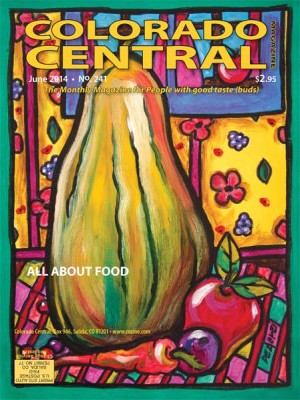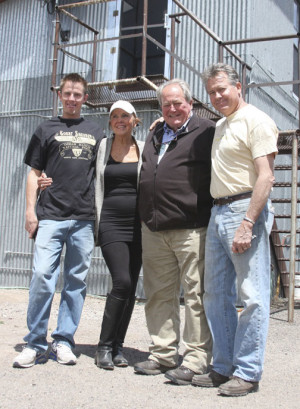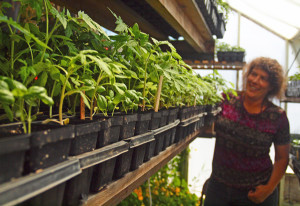by John Mattingly
Anyone who eats beef might enjoy the “watching sausage being made” details of how it is produced, starting with the cow-calf end of the business.
So let’s pretend that you, the reader, just bought 100 running age cows, three to eight years old, and open, meaning they are ready to breed. There are several places to start this example, such as buying cow-calf pairs, or cows that are already bred, but buying good, open stock that you can breed to bulls of your choice, at a timing of your choice, is a typical and good place to start.
Let’s say you got a good deal: $1,500 a head for the cows and five bulls at $2,500 a head. With shipping and inspections, and the purchase of your very own cattle brand, you have an initial investment of about $130,000. It’s June, and you have good pasture for the cows through September at a decent rate of twenty dollars per head per month. The gestation period for a cow is nine months, like humans. You don’t want to breed the cows to calve in deep winter, so you keep the bulls in a separate pasture until July, so they will start breeding the cows to calve starting in April of the following year.
There are some ranchers who prefer to have the calves in January because then the calves are big when summer grass comes along, and the calves will thus weigh more at weaning. But there are additional costs associated with calving in cold weather, such as calving facilities, more feed, extra labor and an increased probability of death loss. Much depends on the typical weather for the region of the ranch, the available facilities, and how much of the ranch was inherited from a father who also inherited it from his father. As a result, theories and convictions about the timing of calving run as wide as they do deep.
There are also ranchers who use artificial insemination and heat synchronization of the cows as an alternative to bulls. Again, this requires additional management, time, feed and thus expense.
It may be that these various management alternatives result in financial advantages, so we will set aside their consideration until after you, the reader, now the proud owner of 100 cows and five bulls on good pasture, have a couple of years under your belt as a new rancher.
Your cows are out there eating grass and it seems pretty simple, even beautiful. This is what our creator meant by dominion: animals eating grass that we can’t eat, making burgers, roasts, ribs and steaks that we can eat. It makes sense. It seems like this enterprise of turning grass into meat should be inherently profitable.
You have to provide salt for the grazing creatures, a decent scratcher, shade (if possible), and you may have to fix some fence. The bulls might get ornery and break out, and there might be some cows with cancer eye, or an infection, or signs of carrying hardware, or simply going off feed and getting down in the back. But these are interval problems in an otherwise easy flow of animals peacefully grazing.
To check the cows and be there for fencing and health problems, you will need a pickup truck and a trailer – a reliable set will cost you about $15,000. You also need a horse or a four-wheeler to work and check the cows on pasture, and that will cost another $3,000. All of these transportation-related items require maintenance, fuel (hay to a horse), licenses and insurance, which will run you another $1,000 a year.
In July, you turn the bulls in with the cows. Initially, you have to watch that the bulls start “chinning” the cows right away. Any bulls that are shy or easily intimidated by the other bulls should be replaced, and any bull that commits the unforgiveable sin of monogamy must be removed and made into hamburger. Unlike in the social norms of human culture, a monogamous bull is worthless. A good bull is aggressive and pluralistic, “chinning and covering” at least twenty cows in two heat cycles (about 42 days). Because bull performance is so critical to the calf part of the cow-calf operation, there are private enterprises that test bulls. Prior to the breeding season, you bring your bulls to a Bull Motivation Center where they are cleared of venereal diseases, assessed for sperm count, and then put through a battery of exercises that determine their BQ, or Breedability Quotient. Any indication that the bull is weak, same-sex oriented (a “Liberace”), or monogamous can be detected.
Because you want to do a good job with your cows, let’s assume you wisely had your five bulls tested at a local BM Center, and all were given high BQ marks. Though this will cost $2,500, it is cheaper than replacing a lazy bull in the middle of the season. Not only would a replacement bull cost another $2,500, but removing one bull from a group of bulls always causes a disruption among the remaining bulls; this results in the bulls having to fight to re-establish their hierarchy, which dissipates a lot of valuable energy that they need to be applying to chinning the cows. And bullfights often injure the bulls’ tallywhackers, which, for three heat cycles, is the most important part of their otherwise massive anatomy.
The bulls are removed in September, after being with the cows for two months (three heat cycles). Some ranchers expose their cows for only two heat cycles so that most of their calves will be born in a shorter period, but they typically leave one “clean-up bull” with the herd to catch any “straggler cows” that did not breed on first exposure. A few ranchers leave bulls with their cows all the time, but this results in calves being born at all times, resulting in an irregular calf crop. For the purposes of our example, we are going to remove the bulls after two months and put them in a separate, lonely pasture where they will rest for about 10 months. We therefore expect our calves to be born in a fairly narrow time range, producing a nice even package of feeder cattle for the feedlot buyers. You want your calves to come through the ring looking like they came from “reputation cattle.”
In October, the summer grass is consumed, and the cows will move to a hard grass, dry grass, or perhaps an “aftermath” pasture of corn stalks or volunteer grain, or well-frosted alfalfa pasture for the next eight months. This pasture is cheaper, at 10 dollars per head per month. In November the cows are brought into a facility and “preg checked.” In your new herd, there will be five cows which did not breed. You will sell them, because the cost of carrying an unbred or “open” cow through the winter is not cost effective. The open cow will likely go to the “killer” or “canner” market at a discount, selling for $600 a head. But that $3,000 will come in handy.
The cows and bulls will consume about two tons of hay per head from around December through April until summer grass is again available. The cows do not need high-quality feed in the first trimester of pregnancy, but they need excellent feed in the final trimester, which is when most of the hay and supplement is fed. When the cows start calving, and for the two months following calving, their feed needs to be top quality, because the cow is recovering from parturition, nursing a new calf, and also preparing her reproductive system to clean out and breed again. During this time it is common to feed a modest supplement of corn, oats or a non-protein nitrogen source with molasses that the cows can convert to protein in their gut. This will cost $10 a head and is money well spent, because you want the cows to have plenty of milk for their calf and breed back quickly.
During calving you will have to monitor the cows, and you will lose three of the calves from your 95 cows (remember: five cows were open and sold). The three cows that lose their calves you can either keep or sell, but it is best to sell for another $1,800. The remaining 92 cows and calves go to grass in June, though now you have cow-calf pairs and this pasture will cost $30 per head per month. The bulls join the cow-calf families on pasture in July.
You will put out a “creep feeder” of corn and salt for the calves in a cage that cows and bulls cannot access, to stimulate the growth of the calves, at a cost of another $5,000. You will bring the cows in and treat them for flies by pouring a deterrent on their backs, and you will brand the calves, give them shots and castrate the bull calves at a total vet cost of $5,000. By November you have calves to sell, and you are definitely thinking, “it’s about time I had something to sell!”
You have 92 calves – 50 steer calves and 42 heifers. You keep 10 of the heifers to replace the cows you have sold that were open or that lost their calves. It is both standard and wise to replace your cow herd with calves from your herd. The steers weigh 575 pounds and the heifers weigh 525 pounds across the scales at the local sale barn, fetching $700 and $600 per head respectively. Your total gross income after shipping and commissions is $35,000 plus $20,000, or $55,000. It’s nice to pick up that check, because you have a lot of bills to pay.
It’s now been 18 months since you bought the cows and bulls. The cost of the capital, whether borrowed or from your savings, is five percent, or about $10,000. If you borrowed from a bank, a typical operating loan would be seven to eight percent, but if you took your own money out of, say, T-bonds, it would be yielding about three percent, so let’s use five percent as a reasonable average, resulting in a cost of capital – actual or opportunity – at $10,000 for the 18 months between the purchase of the cows and the first sale of calves.
The following is a broad-brush profit and loss:
INCOME:
1. Sale of culls: $ 5,000
2. Sale of calves: $55,000
TOTAL INCOME: $60,000
EXPENSE:
1. Capital: $10,000
2. Pasture: $28,000*
3. Hay: $30,000 (200 tons at $150)**
4. Supplements: $8,000
5. Vet, supplies: $4,000
6. Overhead: $5,000 (truck & trailer, four-wheeler or horse)
TOTAL EXPENSE: $85,000
* Pasture is based on four months first summer’s pasture at $2,000 a month (100 head x $20 a head per month), or $8,000 total, and eight months dry pasture at $1000 a month (100 x $10 a head per month) or $8,000 total, and four months second summer pasture at $2,500 a month (100 x $25 a head per month) or $10,000 total, and two months dry pasture at $1,000 a month.
** Good hay in the current market is closer to $200 a ton.
After selling the calves, you have 102 running- age cows, and you are down $25,000. You also need now to buy two hundred tons of hay to get through the winter at about $30,000. Before you sell your second calf crop, you will be down about $100,000 and before your third crop, your debt could equal your initial investment: $130,000. In other words, you spent $130,000 on 100 cows, and four years later you are in hock for about $250,000. This is where it pays to have a job in town, or an oil well. If you have a reliable income source, you can write off the expenses of your ranching hobby against that income, and with a combination of tight management and some creative accounting, you can reduce the cost of owning your pet cows.
You can see how the likes of Cliven Bundy have survived all these years. Inheriting the home ranch and the cows from his father was a great way to start, and then using federal lands for grazing (mining, really) at greatly reduced rates, Bundy and his cohorts cut down the pasture and hay bill to the point where they could afford a new $60,000 pickup every year and have time to indulge in social commentary.
Author’s note: Next month we will pretend you own a feedlot and detail the ways in which this is a profitable business, but only at the expense of the cow-calf producer and the health of the animals.
John Mattingly cultivates prose, among other things, and was most recently seen near Poncha Springs.




